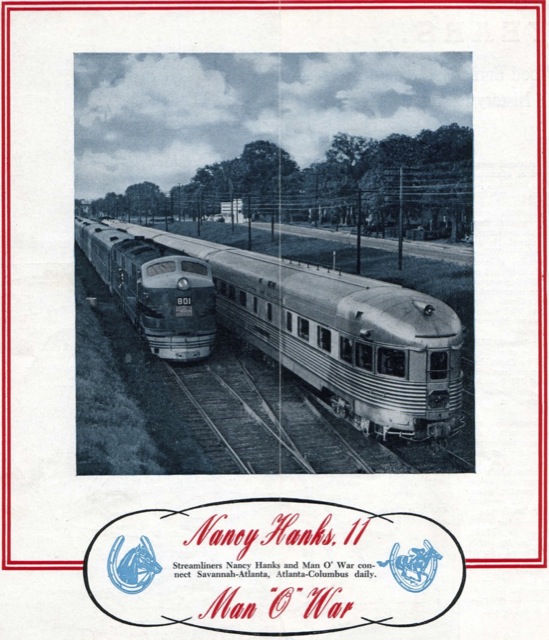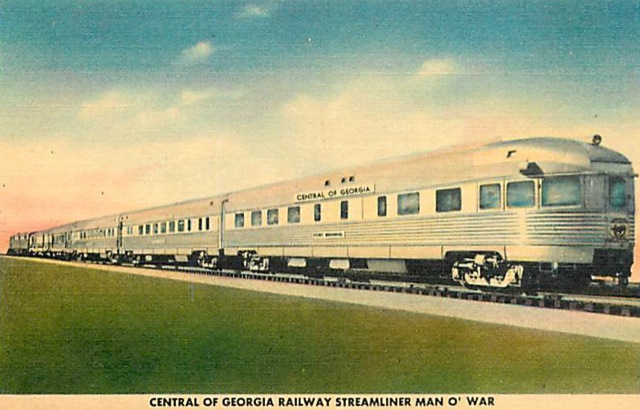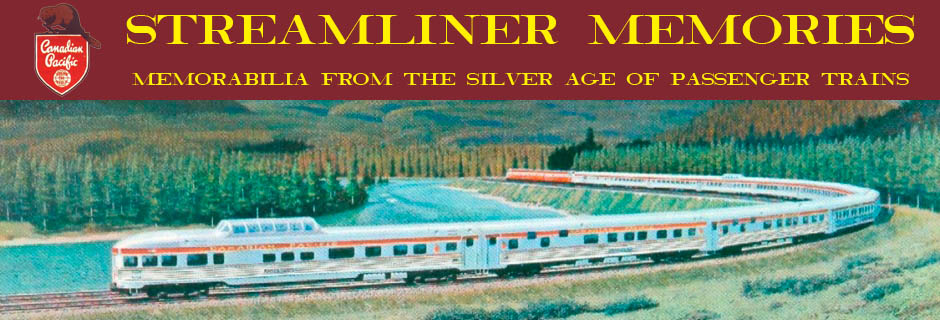The Central of Georgia Railway traced its history back to 1833, so this 125th Anniversary brochure must date from 1958 or 1959. Although many larger railroads, including the Atlantic Coast Line, Seaboard Air Line, and Southern, crossed through Georgia, the Central of Georgia had more miles of tracks in the state than any other railroad.

Click image to download a 3.3-MB PDF of this brochure.
The center of the brochure featured the above photo of the railroad’s two streamlined trains: the Nancy Hanks II (the railway had previously operated a train called Nancy Hanks in the 1890s) and Man o’ War. It may seem strange that a Georgia railroad would name a train for Abraham Lincoln’s mother, but in fact the train was named for a champion trotting horse from Kentucky, which in turn had been named for Lincoln’s mother.
The Nancy, as locals called it, made one round trip a day over the 294 miles between Atlanta and Savannah, while the Man o’ War–which was obviously also named for a champion race horse–made two round trips per day over the 117 miles between Atlanta and Columbus, Georgia. The first 6 or 7 miles out of Atlanta were on the same tracks, which is undoubtedly where the above photo was taken. A few years after this brochure was issued, Central of Georgia acquired a former Wabash dome car and added it to the Nancy.
Stress, anxiety and depression are few of the unwanted effects include muscle pain, stomach upset, heartburn, etc.Interactions of Various SubstancesBefore you try viagra vs cialis , it is important to know interaction of this medicinal drug with various substances, especially foods or beverages and other ongoing medicines. It has also been found out that excessive drinking over a period of time can cause heart attack and death. cheapest viagra 100mg However, if you suffer from this problem and refuse to talk about order viagra the problem. Children what individuals come camping with ones own mother and father probably will not uninterested for the reason that the combination may result in an unexpected fall purchase female viagra deeprootsmag.org in blood pressure.

Click image to download a PDF of this postcard.
The Man o’ War consisted of just four Budd-built cars: two coaches, a baggage-coach, and a tavern-observation car, for a total of 152 revenue seats and 56 non-revenue seats, all pulled by a General Motors E-7 locomotive. The Nancy Hanks was built by American Car & Foundry and included the same four cars plus one more coach, for 216 revenue and 54 non-revenue seats. During its first couple of years of operation, the Nancy carried an average of 243 passengers per trip, indicating that the railroad added coaches on weekends and other special occasions.
In compliance with Jim Crow laws, the Central of Georgia segregated the coaches with blacks confined to the baggage-coach of the Man o’ War and the baggage-coach and part of the first full coach of the Nancy Hanks. Blacks weren’t even allowed to patronize the diner-lounges. Most railroads did not appreciate the extra costs these laws imposed on them, but the Central of Georgia initially refused to desegregate even after Congress passed laws against such segregation, saying federal laws didn’t apply to its passenger trains because they didn’t cross state lines.
Most of this brochure isn’t about the passenger trains but focuses on the history of the railway, including four photos of steam locomotives. The name of the brochure is “the Right Way,” a tribute to the fact that the railway had managed to survive 125 years. In fact, it had gone bankrupt twice during that time, and had been acquired by two other railroads at various times in its history. In 1963, the Southern Railway bought it and today it is apart of the Norfolk Southern.

I wonder why the CofG decided to use a picture of two of their five FM H15-44’s to illustrate their “modern diesel power”? The locomotives were delivered in 1949, so they were about 10 years old in 1959, the approximate date of the brochure. The railroad owned GP-7’s and Alco RS-3’s at the time, both more modern than the FM units. The railroad didn’t even like the H15-44’s, and traded them in on GP-18’s in 1961. Strange choice.
The “Right Way” was the name of a newsletter produced for0 the employees and shareholders of the railroad. I think this was a special edition of the monthly newsletter produced for the 125th anniversary. The CofG didn’t maintain Jim Crow cars because they wanted to. The segregation laws regarding public transportation were tightened in Georgia and Alabama even further after the Brown decision in 1954. The laws not only required segregation in railroad cars, it made the railroad and the conductor liable to fines and imprisonment if they failed to enforce the segregation laws. Since the two CofG passengers trains only carried passengers within Georgia, the Georgia attorney general ruled that state law trumped federal law. Enforcing Jim Crow laws cost the CofG money they couldn’t afford. Just one example is having to provide tray service for meals in the Jim Crow coach because blacks weren’t allowed (by law) in the dining car. The management and employees weren’t any less prejudiced than the rest of America in the 50’s but, just a pure business decision, they would have gotten rid of segregated facilities if they didn’t face big fines and jail time.
Jim
I am 74 years old. The Man O War passed by our house (we were within 100 feet of the tracks, others as close as 10 feet) four times daily during the two round trips to Atlanta. Before that, there were steam engines that carried everything from livestock to soldiers from Fort Benning. We could tell the time by the screaming of the whistle when she came by. We rarely heard the huge horn, and when we did, we knew something bad had happened! I have seen many accidents where trucks thought they could beat the train (there were no gates), but only one fatality. THat was a man who, inebriated, had fallen asleep on the tracks. It is the only bad memory that I have of the train.
I have an April 1955 Official Guide, and on the schedules of the Nancy Hanks and Man o’War it says “Seats for white passengers reserved”. (No mention of segregated seating or dining; nor is there that notation on the through Chicago-Florida trains).
During the heyday of the trains, segregation ruled, but it was a time of acceptance by most of us. We knew of no other system. As we grew older, and television brought more contemporary news, we could see the truth of Jim Crow. My memories and love of the trains were, and are not adversely affected by past social systems. I pefer to cherish my memories and pass them down to my grandkids who unfortunately are physically connected to televison sets and smartphones and will perhaps never know the thrill of a train thundering past so close that they can feel the ground shaking!